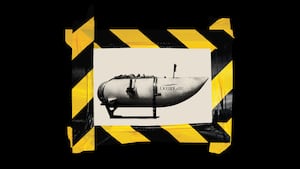When OceanGate Inc. offered Robert Mester a voyage aboard the Antipodes, a predecessor to the Titan, the privately operated five-person submersible that imploded while descending to the wreckage of the Titanic, he politely begged off the expedition.
“They were using off-the-shelf hardware from Radio Shack to operate inside, and quite frankly we’re talking about an environment that requires robust equipment that has certifications and qualifications that are established by different agencies for man-rated submersibles,” Mester, a deepwater salvage master and former Marine based in Washington State, told The Daily Beast. “None of the equipment that I saw inside the submersible was up to that [level], so I just chose not to go. Quite frankly, I found something else to take that time up, rather than take the trip.”
Mester said he later boarded the Titan while it was on dry land, but, as before, decided he would not be willing to dive on the craft.
“[The Titan] has a carbon fiber hull, which, how do I put this… it’s not a material that’s ever been successfully used at great depths,” Mester said.
The Titan was about an hour and 45 minutes into its roughly two-hour descent on Sunday to the Titanic site, which sits 400 miles off the coast of Newfoundland under 12,500 feet of water, when it lost contact with its mothership. It was carrying two crew and three passengers, who had each paid $250,000 for the trip. At a press conference on Thursday afternoon, the Coast Guard confirmed that the Titan was thought to have imploded after a “catastrophic failure” of the vessel’s pressure chamber. OceanGate quickly issued a statement saying all five people aboard the Titan had “sadly been lost.”
Mester, for his part, said he believed from the start that the Titan had imploded. Based on his knowledge of Titan’s operating procedures, Mester said he thinks the Titan would have imploded at roughly 4,000 to 5,000 feet down, around the same time it lost contact with its mothership.
“The pressure at that depth is a ton-and-a-half per square inch,” Mester said. “It wouldn’t take much of a failure to cause an implosion, and it would have been instantaneous… a submersible can drop weight and come back to the surface, but nothing has gone beyond that one-and-three-quarter-hour timeline when they lost communication.”
Although some questions have now been answered, Walt “Butch” Hendrick, a former marine rescue trainer for the Green Berets who now runs a commercial marine salvage company, said there are still mysteries to be solved. He sees the implosion as having been caused by a combination of factors—extreme conditions at depth along with half-baked equipment.
“I don’t think the vessel was built all that well, and I don’t think it was maintained all that well,” Hendrick told The Daily Beast.

Pakistani father-and-son Shahzada and Suleman Dawood, OceanGate CEO Stockton Rush, British billionaire Hamish Harding, and French explorer Paul-Henri Nargeolet were aboard the doomed submersible.
ReutersA catastrophic failure of the sort that befell the Titan may have simply started as a small leak, according to Hendrick, who compared the situation to that of a leaky boat. The difference is, “if you had a small leak in a boat, you might be able to stick a towel or a rag in it and keep the water from coming in until you got back to shore.”
At several thousand feet underwater, “the pressure change finds the weak spot and BOOM, it’s all over,” Hendrick went on. “You know what a flash fire is? It incinerates everything around, and it’s over in less than a minute. When you get a catastrophic failure that is an implosion, [the Titan passengers] were already dead and they never even knew what happened.”
Hendrick then paused, and added, “That is what we’re hoping happened.”
It would have been a quick and painless demise, according to adventurer G. Michael Harris, who has been to the Titanic wreck site aboard Russian submersibles. He said Thursday on Fox News that an implosion “is definitely the way to go.”
“Two nanoseconds for that vehicle to implode and it would take your spinal column four nanoseconds to register to your brain,” Harris said.
It takes a lot of money to keep a commercial submersible running, and Hendrick speculated the Titan simply “could have been down too many times.”
“How many times can you squeeze a Coke can before it wants to fall apart?” he said, adding, “How sturdy does it need to be?”
“You can’t pressurize the inside of that submersible to be equal to the outside pressure, because you wouldn’t be able to function,” Hendrick continued. “The oxygen level alone would have killed you before you even got to 300 feet of pressure.”
Right now, the debris field has remained at the bottom and none has floated to the surface. Until crews are able to recover a major portion of the Titan, “we don’t really know what happened,” Hendrick said.
“What they have right now is the outer cone and a couple of exterior pieces,” he continued. “Nothing ever came to the surface. It was a catastrophic failure, some of the portions should have been at the surface. Why not?”
Implosions are rare, according to Hendrick. And if the Titan hadn’t caved in, being lost at depth for that long would still likely have been fatal, said Mester.
“The fact that the submersible is not heated means that if they were alive, waiting on the bottom for a rescue to come, hypothermia would have set in before too long,” he said.
That possibility had been considered by Captain Paul-Henri Nargeolet, who perished aboard the Titan.
As Nargeolet once said, hypothermia “is not a bad way to die because you fall asleep and you don’t suffer, in this case.”
Mester does see a potential silver lining in the devastating chain of events, saying, “Tragedy sometimes is the catalyst for bringing about change and betterment.”
He hopes now the Titan disaster may lead to a reckoning in which people will demand more stringent regulation for such vessels, and that journeys like this will only take place if adequate recovery systems are in place from the get-go.
Many have expressed concern about the technology used to operate the Titan, which, as an experimental vehicle, never had to meet international safety standards, Hendrick pointed out. Past passengers have described the experience of being aboard the Titan as a “suicide mission,” and the vessel lacked even a basic safety beacon to alert rescuers to its location in the event of a disaster. Some recalled the sub experiencing total electrical and communications failures, which one person said seemed to be “baked into the system.”
“You don’t just allow anybody to build a submersible, charge $250,000 per person, and hope they make it down and make it back up again,” Mester said.
When airplanes crash, regulatory agencies from all over the world come together “to find out, circuit-by-circuit, what happened, so they can make that type of travel safer,” he continued.
“We don’t do that with operations underwater,” Mester said. “But that era is straight upon us. This is the jump-off, and they’re going to have to start looking closely.”







